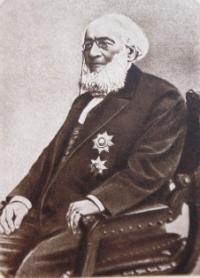You are here
Walk on Ivanovsky Belok on Altai.

Trip to the Altai Kazakhstan Mountains.
“Especially picturesque were the views from some of these elevations to the bends of the river and the cliffs hanging over it; to our right was a mountain towering hundreds of meters above the level of the river”
Peter Semenov Tian-Shansky.
Active tourism in the mountains of Kazakhstan Altai.
I return to the continuation of my story. July 25, on the second day of our arrival in Riddersk, we and Koptev climbed Ivanovsky Squirrel. We drove out at dawn in a carriage to the place where r. The thunder goes out of its wild gorge into a valley in which, merging with the Tikhaya River, forms Ulba.
Here we moved to riding horses waiting for us. The first climb was very cool. At a distance of about 250 meters above the valley, on steep, treeless slopes, I met the first plants of the wonderful Alpine Altai flora. These were large golden yellow flowers of the Alpine Altai poppy (Papaver nudikaule), blue gentians (Gentiana procumbens) and dark purple saxifrage flowers (Saxifraga crassifolia), large, round leaves of which are used by locals as a substitute for tea called "Koporsky" tea.
When we reached the forest ridge, our climb lost its steepness; but the forest was barely passable. Felled trees lay across the path that disappeared into the dense thickets. Even in the glades of grass and shrubs reached the rider to the waist, but these were European types of plants.
When climbing another 130 to 150 meters, the birch disappeared, and the forest became completely coniferous: larch and Siberian cedar joined the spruce and pine. In the same place, where steep slopes were found, naked from forest vegetation, they were covered with Alpine herbs of the Altai flora: they were a pale violet catchment (Aquilegia glandulosa), a pale yellow mytnik (Pedicuiaris), bright yellow flax (Linum sibiricum) and yellow onion (Allium fl) blue snakeheads (Dracocephalum altaicum and Dr. grandiflorum), Altai species of small grass (Silene) and beetle (Bupleurum), and some, however, of the European type, orchids (Cymnadenia conopea, Coeloglossum viride) and others.
Even higher - by 150 meters - larch and spruce began to disappear, and even the pine trees were covered with needles only on the western and north-western sides, and on the south-eastern, under the influence of dry continental winds, they were completely naked.
Even higher, the pines lost the character of the trees and turned into a stunted stanza, in the clearing between which appeared Altai forms of a high alpine character: stunted, with large, mostly bright flowers. They were pink drya flowers (Dryas octopetala) and blue gentian flowers (Gentiana altaica, pratensis, glacialis, silvestris and obtusa), clad in rocks, the most delicate and delicate, Gentiana glacialis, exhibited from the cracks of the rocks.
White and yellow saxifrages (Saxifraga), patrinia (Patrinia rupestris), and many compound flowers: small petals (Erigeron alpinum), bitterness (Saussurea pygmaea and S. pycnocephala) and white, fluffy stars of cut grass Le alpinum).
Finally, having traveled around the top of the Ivanovo Squirrel on a long arc from the south side, we climbed it. A fairly vast area forming this peak consists of many flat granite rocks. The view from the outskirts of this square was extremely extensive and majestic.
Behind the wild ravine of Gromotukha was closed by a ridge of Ulba proteins, between which Passing and Rasypny paid particular attention to themselves. Ahead were the Turgusun squirrels, and to the left through the Ridder valley in the striking blue distance were the Ridder Sinyukha and Ubin squirrels; Unfortunately, many of the mountains were shrouded in clouds at this time.
Everywhere on the northern slopes of the mountain peaks wide stripes and spots of snow were visible, but a continuous snow cover, as in the Altai Belukha or the Tien Shan, was not visible on all these squirrels. We have just ascended to the top of the Ivanovo Squirrel, when a strong wind hit a cloud on us, covering us with a blanket of thick fog.
On the outskirts of the peak we found a table set by the famous botanist Ledebour at the place where he made his measurement. The bad weather prevented me from making a hypsometric measurement. The temperature dropped to 4° while in Riddersk it was 14°.
Having stayed at the top for about an hour, already in impenetrable fog, we began to descend along the steep granite northwest slope, on which high alpine grasses luxuriously bloomed near wide snowy stripes: pink cortusa (Cortusa matthioli) and soft white anemone (Anemone narcissiflora), Cladonia acutifolia , outbreaks (Sedum elongatum), Gymnandra altaica, gentians (Gentiana altaica and G. glacialis) and other specially Altai and Alpine plants.
The west wind blew with extraordinary force, and, starting from half the descent, poured torrential rain with hail, so that when we arrived two hours later before Gromotukha left her gorge and got into the crew, we were already wet to the bone.
Authority:
Peter Semenov Tian-Shansky. "Travel to Tien-Shan”. EKSMO, 2009







